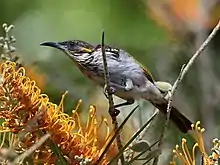White-streaked honeyeater
The white-streaked honeyeater (Trichodere cockerelli) is a species of bird in the family Meliphagidae. It is monotypic within the genus Trichodere. It is endemic to Cape York Peninsula. Its natural habitat is subtropical or tropical dry forest.
| White-streaked honeyeater | |
|---|---|
 | |
| Scientific classification | |
| Kingdom: | Animalia |
| Phylum: | Chordata |
| Class: | Aves |
| Order: | Passeriformes |
| Family: | Meliphagidae |
| Genus: | Trichodere North, 1912 |
| Species: | T. cockerelli |
| Binomial name | |
| Trichodere cockerelli (Gould, 1869) | |
John Gould described the white-streaked honeyeater as Ptilotis cockerelli in 1869, naming it in honour of the person—one Mr Cockerell—who shot the specimen. Gould was unsure of which genus to place it in, noting it had features that linked it to Stigmatops and Meliphaga as well, and even contemplated placing it in its own genus.[2] Alfred North erected the genus Trichodere in 1912, observing that its throat feathers were hairy in appearance, unlike any other honeyeater.[3] The genus name was derived from the Ancient Greek words thrix 'hair' and deirē 'throat'.[4]
A 2017 genetic study using both mitochondrial and nuclear DNA found the white-streaked honeyeater to lie within the clade of the genus Phylidonyris. Its ancestor diverged from the lineage giving rise to the New Holland honeyeater and white-cheeked honeyeater around 7 million years ago, and their common lineage diverged from that of the crescent honeyeater around 7.5 million years ago.[5] Molecular analysis has shown honeyeaters to be related to the Pardalotidae (pardalotes), Acanthizidae (Australian warblers, scrubwrens, thornbills, etc.), and the Maluridae (Australian fairy-wrens) in the large superfamily Meliphagoidea.[6]
References
- BirdLife International (2012). "Trichodere cockerelli". IUCN Red List of Threatened Species. 2012. Retrieved 26 November 2013.CS1 maint: ref=harv (link)
- Gould, John (1869). "Descriptions of five new Species of Birds from Queensland, Australia; and a new humming-bird from the Bahamas". Annals and Magazine of Natural History. 4 (20): 108–112 [109]. doi:10.1080/00222936908696009.
- North, Alfred John (1912). "VI.—Descriptions of Two new Species and a new Genus of Australian Birds". Ibis. 54 (1): 118–20. doi:10.1111/j.1474-919X.1912.tb05287.x.
- Gray, Jeannie; Fraser, Ian (2013). Australian Bird Names: A Complete Guide. Collingwood, Victoria: Csiro Publishing. ISBN 978-0-643-10471-6.
- Marki, Petter Z.; Jønsson, Knud A.; Irestedt, Martin; Nguyen, Jacqueline M.T.; Rahbek, Carsten; Fjeldså, Jon (2017). "Supermatrix phylogeny and biogeography of the Australasian Meliphagides radiation (Aves: Passeriformes)" (PDF). Molecular Phylogenetics and Evolution. 107: 516–29. doi:10.1016/j.ympev.2016.12.021. hdl:10852/65203. PMID 28017855.
- Barker, F. Keith; Cibois, Alice; Schikler, Peter; Feinstein, Julie; Cracraft, Joel (2004). "Phylogeny and diversification of the largest avian radiation" (PDF). Proceedings of the National Academy of Sciences, USA. 101 (30): 11040–45. doi:10.1073/pnas.0401892101. PMC 503738. PMID 15263073. Retrieved 3 August 2010.
